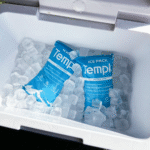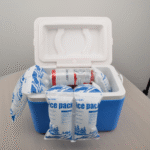How Do Dry Ice Packs Enhance Cold Chain Delivery?
Dry ice packs play a vital role in optimizing cold chain logistics, ensuring that temperature-sensitive goods, such as pharmaceuticals, food, and biologics, are transported safely and effectively. These packs leverage the unique properties of dry ice to maintain extremely low temperatures throughout transit, ensuring that perishable items remain in perfect condition. This article will explore how dry ice packs enhance dry ice delivery, offering superior performance compared to other cooling solutions, and why they are a game changer in the cold chain shipping industry.
-
What are the main benefits of using dry ice packs for cold chain shipping?
-
How do dry ice packs compare to other cooling solutions in logistics?
-
What industries benefit most from using dry ice packs in dry ice delivery?
How Do Dry Ice Packs Enhance Dry Ice Delivery?
Dry ice packs are an essential component of modern cold chain logistics. The cooling power of dry ice comes from its ability to sublimate directly from solid to gas at a temperature of -78.5°C (-109.3°F), absorbing heat during the process and maintaining sub-zero temperatures. This makes dry ice the ideal solution for shipping goods that need to stay frozen, such as vaccines, biologics, and perishable foods.
When packed correctly, dry ice packs ensure that temperature-sensitive products maintain their integrity throughout the entire transit period. Unlike conventional ice, dry ice doesn’t leave behind liquid, preventing contamination and water damage to the products. The absence of water also reduces the risk of spoilage, which is a common issue with melting ice.
The Science Behind Dry Ice Packs and Their Delivery Efficiency
Dry ice is unique in that it does not melt into water but rather transforms into gas, allowing it to provide sustained cooling without creating excess moisture. This characteristic is crucial in industries like pharmaceuticals and food shipping, where excess water or condensation can damage products.
| Cooling Method | Duration | Temperature Control | Best Use Case |
|---|---|---|---|
| Dry Ice Pack | 24-48 hours | Very High | Long-distance shipments of perishable goods and pharmaceuticals |
| Gel Packs | 6-12 hours | Moderate | Short-distance shipping of less sensitive items |
| Ice Packs | 6-8 hours | Low to Moderate | Suitable for non-sensitive goods like clothing |
Key Benefits of Using Dry Ice Packs for Cold Chain Shipping
Using dry ice packs provides several key advantages, particularly in maintaining the integrity of perishable goods during transit. Below are the primary benefits:
Extended Shelf Life
Dry ice is capable of keeping items frozen for 24-48 hours, depending on the size of the pack and environmental conditions. This extended cooling capacity is essential when shipping high-value or highly sensitive items like pharmaceuticals and food.
Cost-Efficiency
By preventing spoilage and ensuring products remain within their required temperature ranges, dry ice packs help reduce waste and loss, making cold chain shipping more cost-effective. Businesses can save money by reducing the amount of spoiled goods and improving customer satisfaction.
Sustainability
Dry ice is a sustainable cooling agent. Unlike traditional refrigerants or gel packs, dry ice sublimates into gas, leaving no waste behind. This eco-friendly property reduces the environmental footprint of shipping, a crucial consideration for businesses aiming to meet sustainability goals.
How Dry Ice Packs Ensure Reliable Delivery
Dry ice packs are particularly valuable when transporting temperature-sensitive products over long distances. They provide a stable, controlled environment, ensuring that the products reach their destination in perfect condition. Whether shipping vaccines, seafood, or biologics, dry ice packs provide the necessary cooling to maintain efficacy or freshness.
Pharmaceutical Shipping
Vaccines, biologics, and other sensitive pharmaceuticals need to be kept within a specific temperature range to remain effective. Dry ice packs ensure these items remain at the required temperature during long-distance transportation, preventing degradation and ensuring safety.
Seafood and Meat Shipping
Fresh and frozen seafood, as well as meats, require constant cooling to prevent spoilage. Dry ice is the most reliable option for maintaining the cold chain and preventing the thawing or spoilage of these goods during shipment.
Dry Ice vs. Other Cooling Solutions
Dry ice packs have a significant edge over other cooling methods like gel packs and regular ice. Below is a comparison of the three cooling solutions:
| Cooling Method | Temperature Range | Duration | Cooling Capacity | Ideal Use |
|---|---|---|---|---|
| Dry Ice | -78.5°C (-109.3°F) | 24-48 hours | Very High | Long-distance shipment of vaccines and perishable goods |
| Gel Packs | 2-8°C (36-46°F) | 6-12 hours | Moderate | Short-distance shipments of food or temperature-sensitive items |
| Ice Packs | 0-5°C (32-41°F) | 6-8 hours | Low to Moderate | Non-sensitive products like clothing |
Dry ice outperforms gel packs and ice in both temperature control and duration, providing the ultra-low temperatures required for some pharmaceutical and perishable food products.
Industries That Benefit from Dry Ice Packs
Pharmaceutical Industry
Dry ice is the gold standard for shipping vaccines, biologics, and insulin. These products need to be maintained at ultra-cold temperatures, making dry ice packs essential to ensure the safety and efficacy of these goods during transport.
Food Industry
Perishable foods like seafood, meats, and frozen meals require constant cooling to preserve their quality. Dry ice packs are ideal for long-distance shipping, ensuring that food remains in optimal condition without spoilage.
Biologics and Research
Many biological specimens, including medical research samples and biological agents, must be transported under strict temperature conditions. Dry ice is the preferred solution to maintain these items at the right temperature to preserve their integrity.
2025 Trends in Dry Ice Delivery and Cold Chain Logistics
The cold chain logistics industry is witnessing significant developments, especially with the rise of advanced monitoring systems and more sustainable methods of dry ice production. Companies are increasingly looking for eco-friendly solutions, and dry ice fits this demand with its minimal environmental impact.
Latest Developments
-
Eco-Friendly Dry Ice Production: Advances in dry ice production technology have focused on using captured CO₂ from industrial processes, which helps reduce environmental impact and stabilize supply.
-
IoT-enabled Monitoring: Real-time tracking systems are being integrated into cold chain logistics, providing businesses with up-to-date information on temperature and shipment location, enhancing security and reliability.
Conclusion and Recommendations
Dry ice packs have become indispensable in cold chain logistics, offering superior cooling capabilities compared to other methods. From pharmaceutical products to seafood and biologics, dry ice packs ensure that shipments maintain their required temperature ranges, improving safety, reducing waste, and enhancing sustainability.
Next Steps
For businesses looking to improve their cold chain shipping processes, incorporating dry ice packs is a crucial step. Begin by assessing the temperature requirements of your products, investing in suitable packaging solutions, and integrating real-time temperature monitoring to ensure compliance and product safety.
About Tempk
At Tempk, we specialize in providing innovative cold chain solutions, including dry ice packs, phase change materials, and insulated shipping containers. Our products help industries such as pharmaceuticals, food services, and research maintain the integrity of temperature-sensitive goods throughout the shipping process.
Contact us today to optimize your cold chain logistics with our professional dry ice solutions!
























